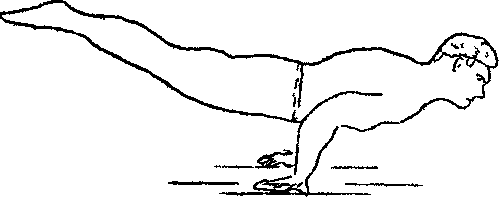In Handbalancing Made Easy, Professor E.M. Orlick explains that there are a number of stunts which will teach you many of the aspects that are needed for a good handstand. Two of these stunts are covered in the downloadable guide. These are the headstand and frogstand. Today I want to talk about one more of the 21 covered in the course.
In his own words these are the benefits on mastering all of these stunts.
The following lead-up stunts constitute stepping stones to perfection. They serve a multiple purpose and are of inestimable value. Taken alone each is a stunt in itself and worth learning even if you had no interest in handbalancing. All of them have something in common to the handstand and thus, pave the way for good handbalancing.
Each accustoms you to the upside-down position of the handstand, each helps to develop the strength, balance and muscular coordination necessary to handbalancing. Many form the very basis of the advanced stunts which will be dealt with later.
Anyone who sincerely desires to become an expert at the art of handbalancing should master each and everyone of these lead-up stunts. Even if you can hold a fairly good handstand now you should practice these stunts, for no matter how good you may be there is always room for improvement.
The Two Arm Elbow Planche.

In addition to being an excellent lead-up trick the two arm elbow planche plays an important part in advanced handbalancing. Many difficult stunts can be built around it.
To perform the trick kneel on the floor, bring both elbows together and place them in your stomach and turn the palms of the hands facing upwards. Now lean forwards slowly and place the hands flat on the floor with your fingers pointing backwards. Arch your back slowly until your toes leave the floor and you will be doing the two arm elbow planche.
You will find the balance a little difficult at first but just keep on practicing. The stunt can also be performed on the edge of a table or on the end of any ordinary bed.
I have also heard this move called many other things, from an elbow lever to a half-arm planche. The obvious next step, and much more advanced, is to switch to doing this move on a single arm.
Why is this stunt helpful? It trains the balancing aspect on your hands from a low center of gravity. You also have to keep a decent arch and your body tight or else you will touch the ground with more than your hands.
Looking back I realize just how helpful these lead-up stunts are. I was going after a handstand before I could easily hold a headstand. Logically, you should go after the easier stunts first before tackling the more difficult.
The great thing about this course is just about every stunt and move shown leads in to the next one. If you want to get the One Hand Handstand then you have eight different lead-up stunts before you even attempt it.
On that note don’t forget you can get early access to ordering the Hand Balancing Mastery Course by signing up for the VIP List at Hand Balancing VIP List
And you can win yourself a free copy by sending in your success story. Don’t forget to do it soon because the deadline for entries is midnight on Monday, November 19th.
Have fun with this one and until next time…
Good Luck and Good Hand Balancing,
Logan Christopher






